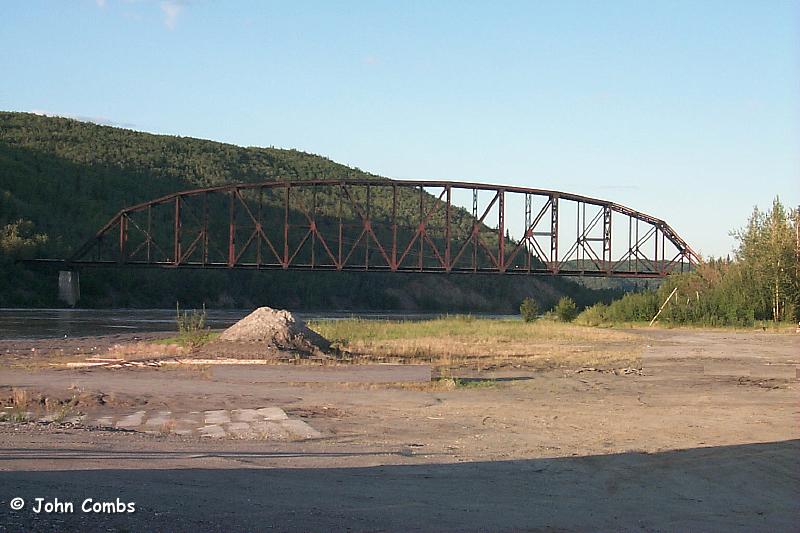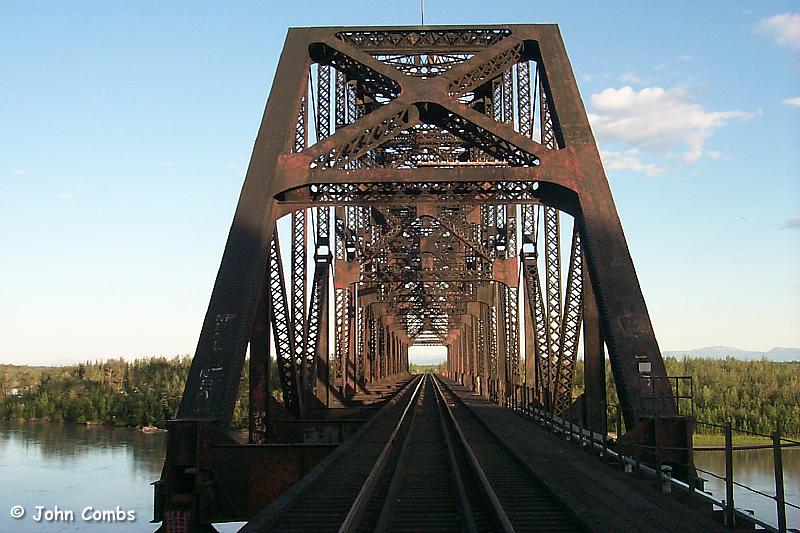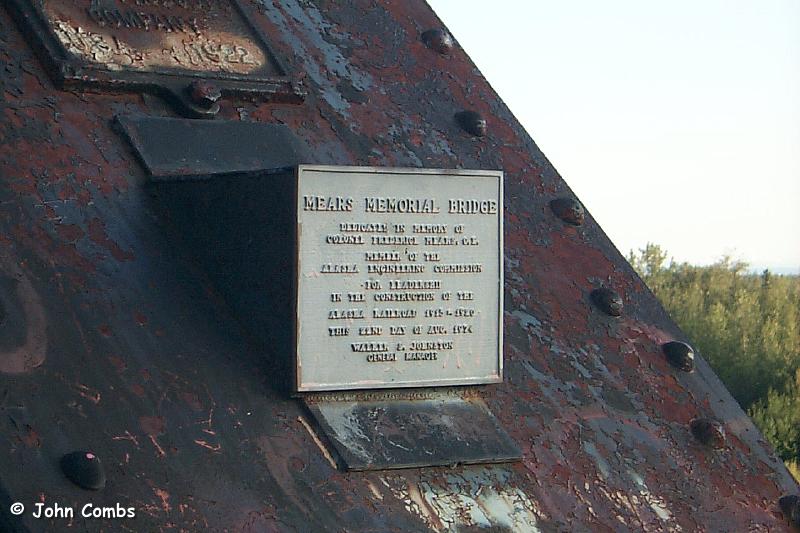





Mears Memorial Bridge, July 31, 2002.
On October 31, 2000 Al Price added, "Hurricane Gulch Bridge was completed in 1921. The main span is a 384' deck arch. It crosses approx. 300 feet above the floor of the gulch. It was designed, fabricated and erected by The American Bridge Co.
"The Mears bridge was completed in 1923. Its main span is a 700' through truss over the Tanana River at Nenana. It was designed by Modjeski and Angier. It was fabricated and erected by The American Bridge Co.
"The bridges are painted with a prime coat of red lead with top coats of black alkyd. The paint on both structures is in fair to good condition depending on degree of sun exposure. The south and west sides of the bridges are in the worse condition. There is very little corrosion taking place even where the paint has peeled to expose bare metal. This is because of our relatively dry salt free climate. Being freeze dried half the time probably helps forestall corrosion!"
On October 31, 2000 John Combs added (source unknown):
It appears Nenana work camp construction was completed in April 1918. Initially, a temporary bridge (for people and carts) was put in place. It was standard truss construction and had wooden planks and hand rails. (This bridge would go out with the spring breakup).
In 1919 tracks were laid south through the Nenana coal fields and onto the foot of Nenana Canyon. The narrow gauge line was connected between north Nenana and Fairbanks.
Influenza hit Nenana in 1920. The northern division reported 75 deaths - 11 railroad employees, 8 contractors, 14 residents of Nenana and 42 natives.
On Tuesday, April 20, 1920 Mr. W.E. Angier arrived in Anchorage to confer with the Alaskan Engineering Commission on their uncompleted bridge program, including the Susitna, the Hurricane Gulch, the Nenana and the Tanana crossings. Mr. Angier is one of the best known bridge engineers in the U.S. A special train took him from Anchorage to Nenana in a record breaking 70 hours.
January 30, 1920 - The first construction team reached Hurricane Gulch. With about 1500 tons of construction material and supplies to distribute between Mile 238 (the present end of steel) and Mile 284, Hurricane Gulch, trails were opened in three to five feet of snow and twenty "four-ups) with an average of 8000 pounds each, are now freighting by that trail.
April 20, 1920 - The depth of snow between the end of steel and Hurricane Gulch now averages from six to 11 feet. A total of 1773 tons of freight was hauled a distance of 16, 296 ton miles.
March 1921 - Aerial tramway built to handle freight and material for the bridge at Hurricane Gulch.
A.E.C. 1921 Report for Hurricane Bridge:
Type: two hinged spandrel arch
Elevation: Pin to base of rail -132 feet
Elevation: Above gulch -296 feet
Span length: 384 feet
Total length: end to end of steel. 918 feet, 2 inches
South approach: Consists of one 50-foot deck plate girder spans and one
120 foot deck truss span
North approach: Consists of three 60 foot deck plate girder spans; two
30 foot deck plate girder spans, and one 120 foot deck truss span
Lumber: 90700 feet BM
Iron: 2140 lbs..
Rock excavation, foundation: 15926 cubic yds.
Backfilling rock: 575 cu. yds..
Concrete in place: 3587 cu. yds..
Reinforcing steel: 50434 lbs..
Bridge steel in place: 3077953 lbs..
June 17, 1921 - Piers appear on north side of Hurricane Gulch.
August 8, 1921 - Hurricane Gulch Bridge nears completion, two sides connected at the bottom
August 10, 1921 - Both sections of Hurricane Gulch were joined completely
August 15, 1921 - First train (work train) passes over Hurricane Gulch Bridge
August 18, 1921 - First regular train (passenger) passes over Hurricane Gulch Bridge
December 12, 1922 - Nenana depot opens for service
Early in the spring of 1922, it was decided to build the Tanana River Bridge which consisted of 201 14-foot wooden trestle spans, one 28-foot wooden span, 420-foot steel viaduct and 120 deck steel span south approach, to 700-foot through steel span and 60-foot girder north approach.
May 11, 1922 - Digging pits for concrete piers for the south approach to Tanana River Bridge
July 30, 1922 - Completion of the south trestle approach for the Tanana bridge
September 1, 1922 - Viaduct piers constructed
December 1922 - The last floor piece was placed. Cars were being handled over the false work bridge.
February 27, 1923 - the bridge over the Tanana river at Nenana was completed. This is the largest span on the Alaska railroad. The 700-foot span was exceeded by only one other steel truss in the U.S. - one at Metropolis across the Ohio river between Illinois and Kentucky. It provided a final link on the north-south route.
During World War II, guards were placed at the railroad's major bridges to protect against sabotage.
On Aug. 22, 1974, the bridge over the Tanana River was dedicated the Mears Memorial Bridge. Mrs. Robert Richards, Col. Frederick Mears' granddaughter, was on hand for the dedication.